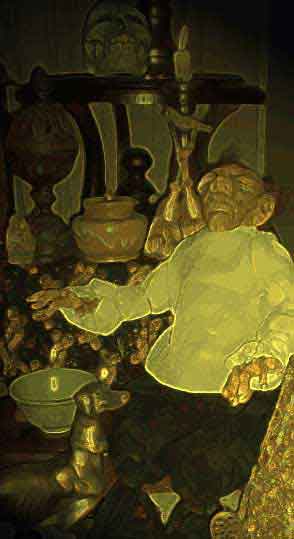As most everyone
knows, the voodoo tradition was brought
to the New Orleans region by African slaves,
often via Haiti and other islands in the
eastern Caribbean. Voodoo’s arrival
in the Louisiana region caused it to interlope
on other traditions already in place, such
as Native American and Atchafalaya Gypsy
nature and rootwork practices. Ultimately,
African Voodoo’s assimilation into
these practices resulted in a potent regional
hoodoo tradition that persists to this day.
Popular among slaves,
some speculate that making voodoo dolls
and sticking them with pins was one method
by which the slave could exert some control
over the master: from the very start white
plantation owners, mostly of European descent,
feared this and its obvious connection to
the more familiar poppet magic of their
cultures. More often than not, however,
the voodoo doll was employed as a weapon
against other believers in voodoo, or vodusi,
who did not hesitate to use it and immediately
recognized its consequences.
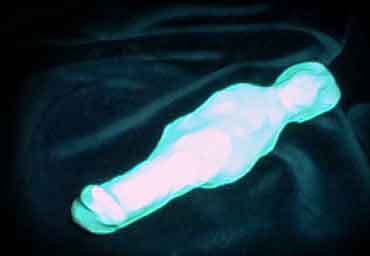
Primitive dolls, often
bound with twine or cat-gut and stuck through
with everything from pins to fish bones,
have been unearthed on several plantations
in South Louisiana, evidence that the concept
of vicarious punishment through use of an
image doll was firmly in place among the
African slave populations of 18th and 19th
century Louisiana.
But the idea of using
voodoo dolls and other forms of hexes such
as gris-gris and mojo, reached its zenith
during the reign of the infamous Voodoo
Queen of New Orleans, none other than Marie
Laveau.
Equally famous for
her hairdressing skills as for her practice
of Voodoo, Marie Laveau rose to fame in
New Orleans during the latter half of the
19th century when her reputation as a powerful
voodoo mambo (or priestess) grew by leaps
and bounds. She was constantly being sought
out by rich and poor alike to lend her aid
in all sorts of requests, some well intentioned
and others not so. Most came to her with
simple requests to make a certain person
fall in love or to secure the healthy delivery
of a baby or an inheritance. But just as
often, there were those who asked
her to use her power to punish and avenge
when they felt they had been wronged in
one way or another.
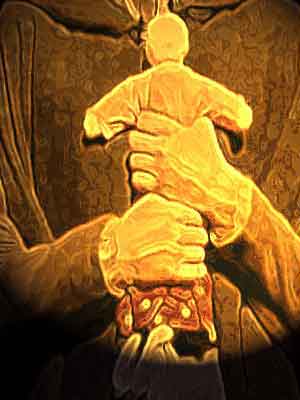
The lore of 19th century
voodoo is filled with the tales of victims
of this vengeful magic who awoke after a
fitful night’s sleep to find bones,
graveyard dust and the inevitable voodoo
doll laying on their porch steps –
placed there in the darkness by Marie Laveaux
herself. The tales would otherwise be a
footnote in New Orleans history were it
not for the fact that, according to reliable
sources, nearly all the voodoo Marie Laveau
performed actually worked. Often, the mere
suggestion that the Voodoo Queen had “worked”
a person would be enough to cause physical
or emotional collapse; this, according to
some accounts, was often followed by actual
death. The power possessed by Marie Laveau
is still at work in the Voodoo practiced
in New Orleans today, and the tradition
of the Voodoo Doll is still alive and well.
Some proponents of Voodoo
as a religion attempt to distance themselves
from the voodoo doll cursing tradition and
there are many examples of dolls created
for more positive purposes such as healing
and spiritual enlightenment. These practitioners
claim that use of voodoo dolls for vengeance
and punishment is a form of Bokor (Black)
Voodoo that has contributed to the bad reputation
the religion has had to bear over the centuries.
But it remains a fact
that most, if not all, people who seek out
a Voodoo practitioner for the creation and
manipulation of a Voodoo doll is usually
bent on vengeance, at a minimum, or often
genuine, irreversible harm. There is something
viscerally satisfying about pricking and
puncturing an effigy of your worst enemy;
the natural expansion of this concept lends
itself easily to the act of greater harm
and the consequent feeling of control one
can obtain from this.
Though in recent years
there have been no actual reports of a person
dying because a voodoo doll was employed
against them, it is still not high on the
list of things a local from New Orleans
wants to see on his or her doorstep any
given morning. No one finding this will
have any doubt as to the intent of the person(s)
who left it there!
The practice of sticking
pins in "voodoo dolls" has history
in healing teachings as identifying pressure
points. How it became known as a method
of cursing an individual by some followers
of what has come to be called "New
Orleans Voodoo", which is a local variant
of hoodoo is a mystery. Some speculate that
it was one of many ways of self defense
by instilling fear in slave owners. This
practice is not unique to New Orleans "voodoo"
however and has as much basis in European-based
magical devices such as the "poppet"
and the nkisi or bocio of West and Central
Africa. In fact it has more basis in European
traditions, as the nkisi or bocio figures
used in Africa are in fact power objects,
what in Haiti would be referred to as pwen,
rather than magical surrogates for an intended
target of sorcery whether for boon or for
bane. Such "voodoo" dolls are
not a feature of Haitian religion, although
dolls intended for tourists may be found
in the Iron Market in Port au Prince. The
practice became closely associated with
the Vodou religions in the public mind through
the vehicle of horror movies.
There is a practice in
Haiti of nailing crude poppets with a discarded
shoe on trees near the cemetery to act as
messengers to the otherworld, which is very
different in function from how poppets are
portrayed as being used by "voodoo
worshippers" in popular media and imagination,
ie. for purposes of sympathetic magic towards
another person. Another use of dolls in
authentic Vodou practice is the incorporation
of plastic doll babies in altars and objects
used to represent or honor the spirits,
or in pwen, which recalls the aforementioned
use of bocio and nkisi figures in Africa.
One Haitian artist particularly known for
his unusual sacred constructions using doll
parts is Pierrot Barra of Port au Prince.
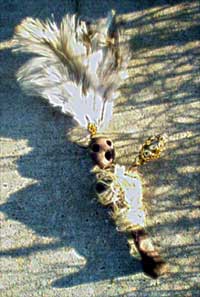
So how
does a simple creature of cloth, wax or
clay become imbued with such power to create
havoc and harm?
More than just consecrating
the doll as the image of a certain person,
a lot of the “magic” of making
voodoo dolls, especially “black”
voodoo dolls, comes from the person creating
it. Traditionally, the maker is instructed
to concentrate all her thought and effort
into the making of the doll, envisioning
during the construction all the evil that
can possibly be heaped on the victim. Some
practitioners will spend days in the creation
and “charging” of their doll,
keeping it in sight and venting their anger
and frustration at the doll until, when
the time comes, the doll is finally given
the name of the intended victim and the
ritual abuse of the voodoo doll can begin.
This process, according to experts in the
field, rarely fails, unless the will of
the creator falters at some point. The resulting
humiliation or punishment of the victim
may then be less potent than otherwise intended.
Bianca the Voodoo Queen
Of New Orleans, began her studies with Voodoo
at a very early age. She does not believe
in using dolls to harm others in any way
shape or form. A noble concept, as what
goes around comes back around. Bianca says
the origin of the New Orleans voodoo doll
was not to inflict pain, but for healing.
Choose between the Money vcome to Me Voodoo
Doll, Heath and Wealth, Peace and Protection,
Love and Passion or Lucky Voodoo Doll.
A form of positive (though
still manipulative) magic for which the
voodoo doll is excellently suited is the
traditional magic “binding.”
In this instance, the practitioner ritually
binds the voodoo doll, charged and named
for the individual in question, from doing
harm or evil toward others. Thus bound,
the ill-intentioned efforts of that person
will come to nothing; the person whom the
practitioner has protected will experience
no harm at the hands of a person thus bound.
Conversely, a person can be bound with evil
intent and although this is often used in
Bokor Voodoo the tradition is an ancient
one. European grimoires are full of rituals
detailing the use of poppets and dolls for
bringing evil to selected individual; many
of these rituals even go so far as instructing
the practitioner to bury the doll in a kind
of symbolic funeral. Once this is done,
the person whom the doll represented will
be seen to waste away and, ultimately, die.
This kind of ritual is not uncommon among
those who use voodoo dolls for evil purposes.
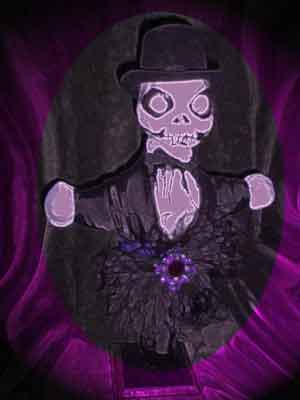
Today there are literally
hundreds of kinds of voodoo dolls available.
Many are the traditional primitive sort,
produced by local voodoo workers for sale
to the public. These dolls can usually be
identified by their similarities to each
other, and often come with a packet of pins
and instructions. Most people who purchase
these dolls will keep them around as a curio,
usually as a reminder of a fun trip to the
Land of Voodoo, New Orleans. Although there
is a tendency to laugh at this trade, to
true practitioners of Voodoo there is a
real danger inherent in these mass-produced
dolls.
“Just don’t
name it unless you really intend to use
it.” This is the warning given by
most reputable mambos or priestesses who
provide such items to the public. Obviously,
how a voodoo doll is used depends on the
person who owns it, but there have been
instances where even the most garish-looking
tourist trinket voodoo doll has ultimately
caused harm – however minor –
after arriving at its destination. The lesson
here should be obvious.
Other voodoo dolls available
to the public are more specialized and are
usually purchased by collectors or persons
who are not unacquainted with the caveats
that go along with owning such artwork.
Many popular voodoo dolls
are created in honor of a particular Lwa,
one of the powerful spirits of the Vodoun
religion, and though there are many styles,
most renditions remain true to the aspects
of the particular Lwa they depict. Probably
the most popular of these Lwa dolls is Gede,
the great Death Lwa, who is represented
in various skeletal forms with colors and
accoutrements easily recognized by his devotees.
Other popular Lwas are Manman Brigit, Erzulie
Freda, Papa Legba, and Lasirien, with her
aquatic motif.
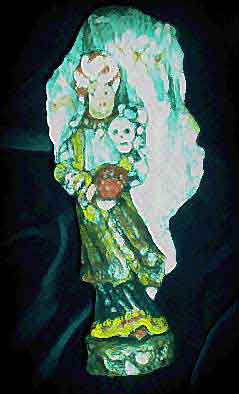
Other dolls available
are rendered in synch with devotion to a
particular Lwa but are designed to invoke
the power of the Lwa in the owner’s
life. These devotional dolls are created
more for actual use than for display, and
since most are one of a kind, created from
an intimate consultation with a practicing
mambo or priest, the dolls are highly prized
and extremely personal. These dolls are
also kept very secure because any ill-intentioned
person possessing such a creation can produce
no end of aggravation and harm to the devotee
it represents.
As you can see, voodoo
dolls come in a myriad of styles and sizes
and can be created for any number of purposes.
It is important to remember that the voodoo
doll as we know it today represents centuries
of magical tradition and as such it should
never be treated lightly, even when it doesn’t
seem to take itself very seriously (such
as the tacky, tourist voodoo magnets mentioned
above). Always treat your doll with respect
and approach it with the knowledge that
it is a creature of craft, your craft or
that of another, and as such it has –
whether you acknowledge it or not –
a life all its own.
Today about 15% of the
population of New Orleans practices Voodoo.
Modern Voodoo has taken several directions:
Spiritualist Reverends and Mothers who have
their own churches, Hoodoos who integrate
and work spells and superstitions, elements
of European witchcraft and the occult, and
traditionalists for whom the practice of
Voodoo is a most natural and important part
of their daily lives, a positive search
for ancient roots and wisdom. The practice
of Voodoo involves the search for higher
levels of consciousness in the belief that
-as indeed all of the ancient scriptures
teach - it is we who must open the way towards
the Gods. for when we call out from our
hearts, the Gods hear and indeed are compelled
to respond.
According to Charles M.
Gandolfo, founder of the Historic Voodoo
Museum, in his booklet, How to Use Your
Voodoo Doll for Serious Practitioners (1993),
the stereotype is untrue: "First of
all the voodoo doll is used about 90% of
the time to help people find love, to keep
a lover, to guide someone in the right direction,
to bring some financial help, or to heal."
He adds, "The other 10% is to influence
that someone that is evil and to send away
that evil person from your life."
